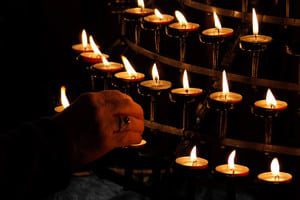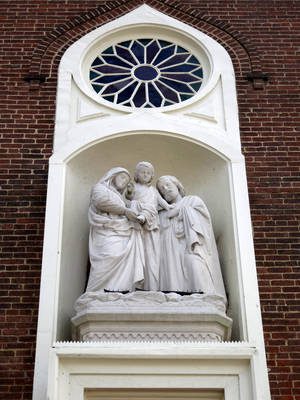
Do you light candles after you say your Catholic prayers? Whenever you go to mass, do you notice the religious statues and beautiful paintings that adorn the church? Have you ever wondered what these artifacts and traditions mean and what value they hold to our faith?
Why do we use statues, paintings and light candles?
We use statues, paintings and other artistic creations and artifacts to bring to mind the person or thing that is being represented in them. Some of us like looking at photographs of our mothers to remember her and the different memories we have together. In the same way, it helps us bring to mind the image of Jesus Christ and the saints and their deeds when we look at images that depict them.

Throughout the years, Catholics have also used different visual representations as a way of teaching. In the early beginnings of the Catholic Church, images and statues were useful for reaching out to people who could not read. Visual art and depictions are generally more accessible and more easily understood compared to written texts hence these became effective mediums of instructions.
The Catechism of the Council of Trent
The Council of Trent was a significant ecumenical (pertaining to the whole Christian Church) council which took place between 1545 and 1564. The council commissioned the Catechism of the Council of Trent to set forth on different doctrines one of which includes the topic of idolatry.
The Catechism of the Council of Trent published 1566 describes “idolatry” as “worshipping idols and images as God, or believing that they possess any divinity or virtue entitling them to our worship, by praying to, or reposing confidence in them.
”Since the early years of Christianity, images of Jesus, Mary and the saints have been used for decoration and devotion. This sometimes creates confusion among non-Catholics and even Catholic devotees who might think that this tradition is a form of idolatry.
The Council of Trent explains this Catholic practice clearly this way:
“The images of Christ, the Virgin Mother of God, and the other saints are kept and honored in churches not because it is believed that there is any divinity or power in these images, or that anything may be asked of them or any faith put in them. The honor shown to them is really being given to the person whom they represent. Through these images which we kiss, and before which we bow with bared heads, we worship Christ and not the saints whose likeness they display.” The Catechism of the Catholic Church (CCC), states clearly, "Idolatry is a perversion of man’s innate religious sense. An idolater is someone who ‘transfers his indestructible notion of God to anything other than God’"
It’s a common practice for us to bow down or kneel in front of statues of Jesus Christ and the saints while reciting our Catholic prayers and as a way of showing our respect. Non-Catholics usually accuse Catholics of violating God’s second commandment against the worshipping idols because of our use of statues, paintings or even the practice of lighting candles.

You shall not make for yourself an idol or a likeness of anything in the heavens above or on the earth below or in the waters beneath the earth;you shall not bow down before them or serve them. For I, the LORD, your God, am a jealous God, inflicting punishment for their ancestors’ wickedness on the children of those who hate me, down to the third and fourth generation. Exodus 20:4-5
Non-Catholics also cite Deuteronomy 5:9 as a way to renounce this tradition because in the verse, God instructs people to “not bow down” to idols. Veneration is different from the sin of idolatry. Although bowing can be used as a posture in worship, not all acts of bowing are expressions of worship.
For example, in Japan, bowing may be considered the Western equivalent of a handshake. People in Japan bow to greet and express respect. Similarly, a person may show reverence to a king by kneeling without actually worshipping the said king as a God. So it is the same with Catholics who kneel in front of a statue while praying is not really worshipping the statue or regarding it as a God.
It’s All About Faith

At the end of the day, it’s all about our faith and where we are directing it.
Here are some personal questions you can ask to give more clarity on the topic of faith and idolatry:
- Do I believe that statues and paintings are God or are am I using these representations to aid me in visually remembering Christ and the saints in heaven?
- Am I worshipping statues and paintings or are they just a means for me to be mindful of the presence of God when I say my Catholic prayers or do any other acts of devotion?

While on a Russian trip, I was very taken with the Icon paintings on the screens and walls around the church and sanctuary, especially in out of the way rural locations. They clearly relate a story to the (at that time) illiterate, especially rural folks. Lovely Byzantine art which is so very religious.
LK